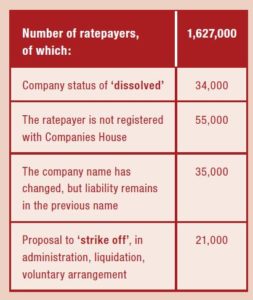 First Published in IRRV Insight December 2019 edition
First Published in IRRV Insight December 2019 edition
All revenues officers will be aware that the road to efficient and effective local taxation collection and recovery starts with accurate billing. Now, for the first time, we are able to look in depth at just how accurate each council’s business rates liability details are.
Comparing liable party names against known company details
By using business rate liability information that is available in the public domain for 99% of local authorities in England it is possible to compare liable party names against company details that are held by Companies House. This information can be used to identify liable companies that no longer exist, that are not registered with Companies House or companies that have changed their name but where the liability for business rates remains in the previous company name rather than the new name.
By looking at the information that is available we can see that councils publish the liable party details of over 1.6 million ratepayers. Essentially, this ratepayer information includes companies, charities and organisations such as councils but excludes sole traders and partnerships as some councils take the view that this is personal information and that to publish it would contravene data protection regulations.
As we would expect, the majority of the 1.6 million ratepayers can be reconciled with the register held by Companies House, with 1.4 million of these having a company status of Active.
Information that aids effective billing and efficient recovery
However, once we start to delve a little further into the detail we can see that there is a great deal of information available to councils that will aid both effective billing and efficient recovery. For example, we can see that 34,000 of the ratepayers are actually companies with a status of Dissolved and which no longer exist. Some of these companies have been dissolved for several months or one or two years, however, there are also many that ceased to exist a number of years ago. More surprisingly, over 13,000 of these dissolved companies are in receipt of small business rate relief.
 Identifying company name changes
Identifying company name changes
Furthermore, there are 35,000 ratepayers where the company name has been changed but where the billing authority is unaware of the name change and continues to issue bills in the previous company name, which could subsequently have an impact upon the effectiveness of any recovery action.
After excluding organisations such as schools, charities and councils we are also able to see that there are 55,000 ratepayers that do not match details held by Companies House at all. In many cases these could be typographical errors where the liable party name requires correction, but in other examples it is the case that there are companies that have never been registered with Companies House , but which are liable for business rates.
Selecting recovery options based on company status
Whilst councils will want to check and correct liability details for the ratepayers detailed above, they may also wish to use the Company Status details that are held by Companies House to determine recovery options in specific cases. We can see that there are 21,000 ratepayers that have a status of Proposal to Strike Off, In Administration, Liquidation or Voluntary Arrangement. As such, councils may decide to monitor collection from these accounts and select a more appropriate recovery option, if required.
For councils to individually check the company status of each of their liable parties would obviously be an onerous task. However, many councils are already using a module from Destin Solutions that matches the council’s ratepayer information against data held by Companies House on a monthly basis, with results being provided in an easy to use solution.
As a result, these councils are best placed to ensure that their ratepayer information is accurate and will remain so in future.
